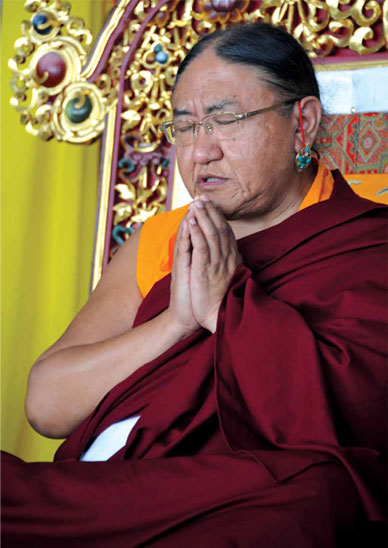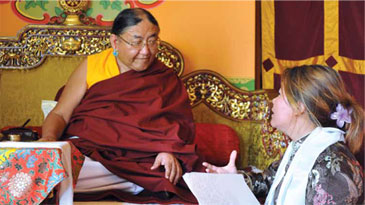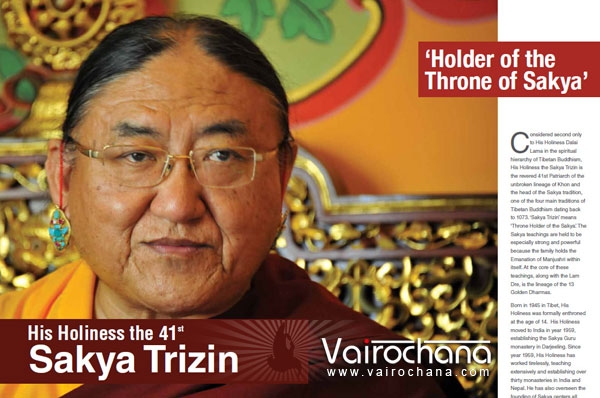V. His Holiness, we are in the Holy Land of Lumbini at this very moment. His Holiness, the Supreme Head of the Sakya lineage of Tibetan Buddhism, would you share with us an account of your life and shed some light on the history of the Sakya lineage?
H.H. You see, in Tibetan Buddhism we have 4 major schools. Sakya is one of them and the Sakya school is founded, established and flourished by the Khon lineage originally believed to be the direct descendants of the Khon Konchok Gyalpo, direct disciple of Guru
 Padmasambhava and Shantarakshita. In fact one of the first Tibetans to receive the fullfledge Buddhist monks’ ordination is also Khon lineage member called Khon Nagendra Rakshita. They were actively involved in the Buddha Dharma and very Great and Highly realized masters but they were all Nyingmapas. After many generations they felt it time to establish a separated school and so Sakya School was founded. Since then Sakya is a separate school still carrying on the Nyingma tradition. We are Sakya which means our main philosophy and teaching came from the Great Master Nagarjuna as well as the Mahasiddha Virupa from these two traditions with study and meditation. This is the brief outline. The Khon lineage is not incarnation. It is hereditary from father to son.
Padmasambhava and Shantarakshita. In fact one of the first Tibetans to receive the fullfledge Buddhist monks’ ordination is also Khon lineage member called Khon Nagendra Rakshita. They were actively involved in the Buddha Dharma and very Great and Highly realized masters but they were all Nyingmapas. After many generations they felt it time to establish a separated school and so Sakya School was founded. Since then Sakya is a separate school still carrying on the Nyingma tradition. We are Sakya which means our main philosophy and teaching came from the Great Master Nagarjuna as well as the Mahasiddha Virupa from these two traditions with study and meditation. This is the brief outline. The Khon lineage is not incarnation. It is hereditary from father to son. V. Monlam: The Great Sakya Aspiration Prayer Festival is held annually. This is the 20th year in Lumbini. Would you please give us a brief history of the Sakya Monlam and the main purpose of performing the Monlam each year? What are the benefits of reciting Samantabhadra’s Aspiration to Noble deeds? Why was Lumbini chosen?
V. Monlam: The Great Sakya Aspiration Prayer Festival is held annually. This is the 20th year in Lumbini. Would you please give us a brief history of the Sakya Monlam and the main purpose of performing the Monlam each year? What are the benefits of reciting Samantabhadra’s Aspiration to Noble deeds? Why was Lumbini chosen?H.H. Actually in Tibet also every monastery has Monlam festival every year. There’s a Great Monlam festival by the Gelugpas but then the Tarthang Rinpoche who is a Nyingma lama made the first contribution to start the Monlam 20 years ago. First he met with every school and in that time one of our Greatest Guru and my own personal Guru, H.E. Chogye Trichen Rinpoche is residing in Lumbini so we chose here. Samantabhhadra prayers is very important because it self says even those who have committed very heinous crimes if you recite it will be purified. The world faces many problems as well as man made problems so to pacify all of these that we recite every year 100,0000 times, one lakh.
V. How does the essence of the Buddha’s teaching help us in this modern day and age? Your Holiness why should we practice Buddhist teaching?
H.H. Whether you practice Buddhist teaching or not is an individual choice. Our basic human problems are still the same. We have emotion problems and although we are in 21st century there’s tremendous material progress, and scientifically technology. High tech is prevailing everywhere but these things are helpful but they don’t solve the real problems. Real problems exist not outside but within our own mind. They can’t be solved through material progress so the only way to solve this problem is through the spiritual guardians and spiritual practice. The Buddhist teaching is very scientific because Buddha himself said you should not believe my teachings just on mere faith, you have to believe through reasoning, though investigations by analyzing it. Therefore it is very suitable in modern times that so many people are interested in learning and studying the Buddhist teachings.

V. How do we practice the Buddhist path? For the modern western Dharma students what would your strongest advice be for them to set them on the right path? What do you thing they need to be most mindful of?
H.H. I think the main thing is they have to study what they will practice. For example the Shantideva’ Bodhicharyavatara (Entering the Path of Enlightenment) is very very important because it explains the whole concept of the Buddha’s teaching through logical reasons. After studying this you apply it in everyday life when you encounter people with emotional problems. V. The Guru Yoga is an important practice in Buddhism. Would you elaborate on it? Would you share your memories with us about the late H.E. Chogye Trichen Rinpoche and his contributions to Lumbini? H.H. Guru Yoga is very important because it is the Guru who introduces you to Buddha Dharma and teaches you how to practice the Dharma. In Hinayana, Mahayana, Vajrayana schools the teacher is very important particularly in the Vajrayana when you receive abhisekh and you receive the initiation and teaching to see the Guru as the real Buddha. H.E. Chogye Trichen Rinpoche is a very Great Scholar as well as very highly realized spiritual master. H. H. Dalai Lama took initiations and teachings from him. So he is the highest.
V. In the year 1970’s in the absence of motorized vehicle traffic, depending solely upon bull carts for building supplies and six years in the making H.E. opened the doors of the temple Dharma Swami Maharaja Buddha Vihara. Could you tell us the significance of the temple for Lumbini?
H.H. Lumbini is the birthplace of the Buddha. This is the most auspicious place so Rinpoche felt it is very important to build the monastery. He got help from the Mustang Maharaja and the late King Mahendra who contributed land. All the outer and inner conditions were gathered here so therefore he established the monastery here.
V. The government is marking the year 2012 as VISIT LUMBINI YEAR. What would your advice be for the authorities, paying heed when it comes to Lumbini development?
H.H. The people who come here are Buddhist people to receive blessings. I think they could organize seminars or teachings so visitors can see the place and digest principle teachings of the Buddha whether they are Buddhist or non-Buddhist.

